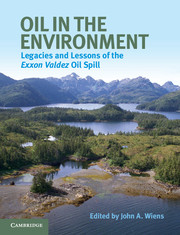Book contents
- Frontmatter
- Contents
- List of contributors
- Use of acronyms
- Acknowledgments
- A bibliographic note
- Prologue
- Part I Introduction and background
- Part II Oil in the environment
- 3 Oil in the water column
- 4 Surveying oil on the shoreline
- 5 Ancient sites and emergency response: cultural resource protection
- 6 Fate of oil on shorelines
- 7 Understanding subsurface contamination using conceptual and mathematical models
- 8 Removal of oil from shorelines: biodegradation and bioremediation
- Part III Biological effects
- Part IV Assessing oil spill effects and ecological recovery
- Part V Conclusions
- Index
- References
8 - Removal of oil from shorelines: biodegradation and bioremediation
Published online by Cambridge University Press: 05 July 2013
- Frontmatter
- Contents
- List of contributors
- Use of acronyms
- Acknowledgments
- A bibliographic note
- Prologue
- Part I Introduction and background
- Part II Oil in the environment
- 3 Oil in the water column
- 4 Surveying oil on the shoreline
- 5 Ancient sites and emergency response: cultural resource protection
- 6 Fate of oil on shorelines
- 7 Understanding subsurface contamination using conceptual and mathematical models
- 8 Removal of oil from shorelines: biodegradation and bioremediation
- Part III Biological effects
- Part IV Assessing oil spill effects and ecological recovery
- Part V Conclusions
- Index
- References
Summary
Introduction
Many microorganisms have evolved the ability to feed on naturally occurring petroleum hydrocarbons, which they use as sources of carbon and energy to make new microbial cells. Most of the tens of thousands of chemical compounds that make up crude oil can be attacked by bacterial populations indigenous to marine ecosystems. A consortium of different bacterial species rather than any single species acts together to break hydrocarbons down into carbon dioxide, water, and inactive residues. Even toxic oil residues, including highly toxic polycyclic aromatic hydrocarbons (PAH), can be detoxified. Microorganisms do not accumulate hydrocarbons as they consume and degrade them, so they are not a conduit for transferring hydrocarbons into the food web. In fact, microorganisms grown on hydrocarbons can be a potential source of protein for animal and human food (Shennan, 1984).
For many years before the Exxon Valdez oil spill, the US Environmental Protection Agency (EPA), the National Oceanic and Atmospheric Administration (NOAA), and other governmental agencies had supported research on microbial degradation of oil in marine environments – biodegradation – and on ways to enhance and accelerate it – bioremediation. These studies showed that, while in many cases biodegradation can mitigate toxic impacts of spilled oil without causing ecological harm, environmental conditions for it to happen rapidly are not always ideal (Atlas, 1995). If water carrying sufficient amounts of oxygen and nutrients cannot reach the oil, rates of biodegradation will be severely limited: oil incorporated into, or on, sediment above the tidal zone, oil buried in low-permeability sediments (Chapter 7), and thick oil layers and tarballs that are not intimately in contact with flowing water are especially resistant to biodegradation.
- Type
- Chapter
- Information
- Oil in the EnvironmentLegacies and Lessons of the Exxon Valdez Oil Spill, pp. 176 - 197Publisher: Cambridge University PressPrint publication year: 2013
References
- 3
- Cited by



